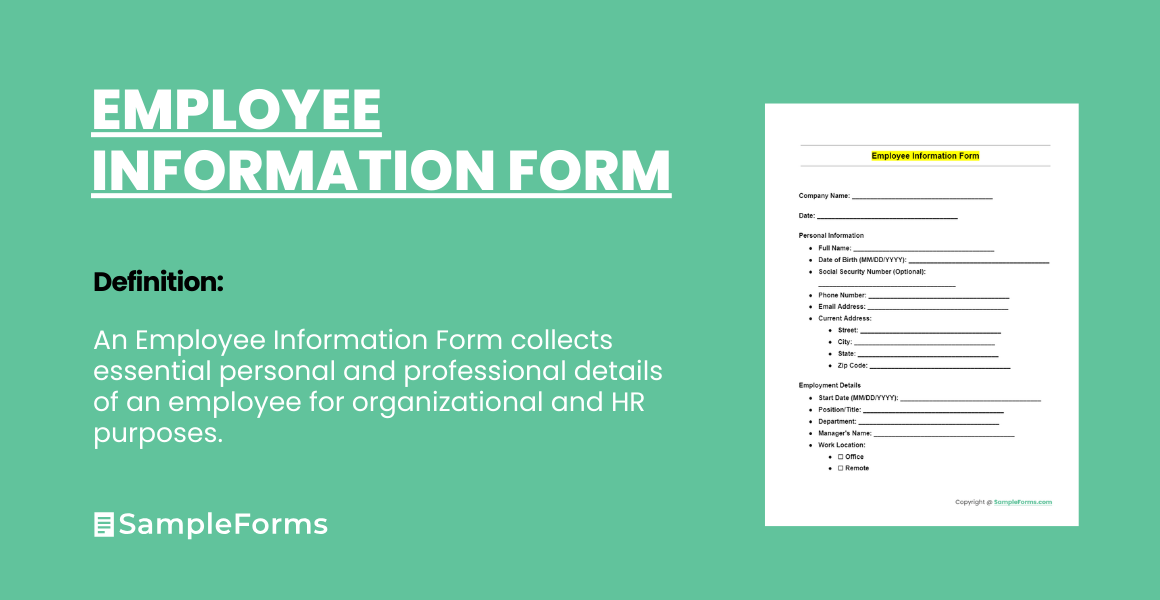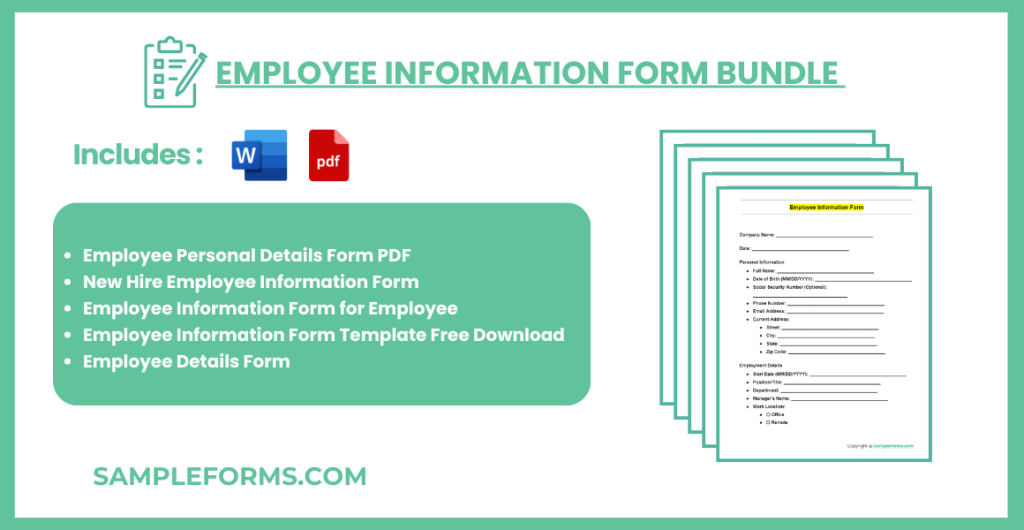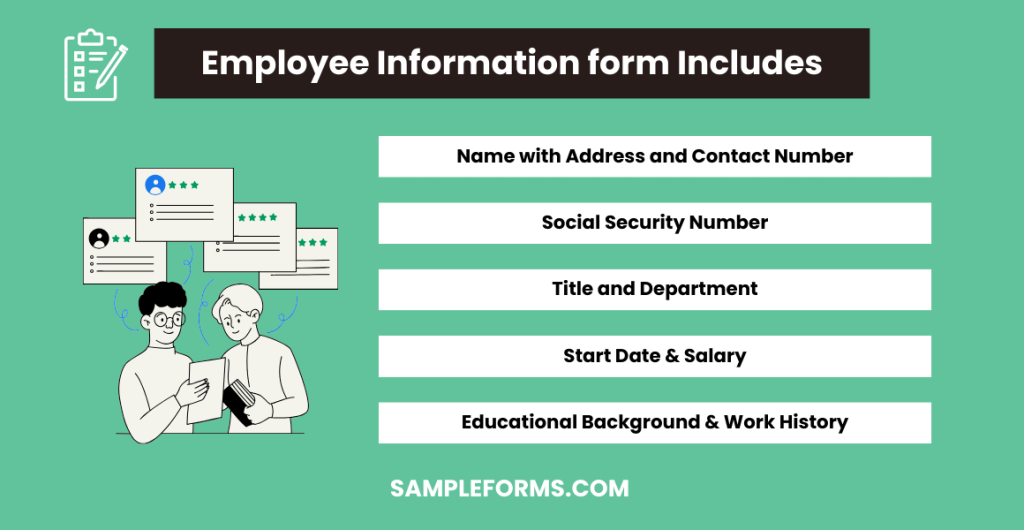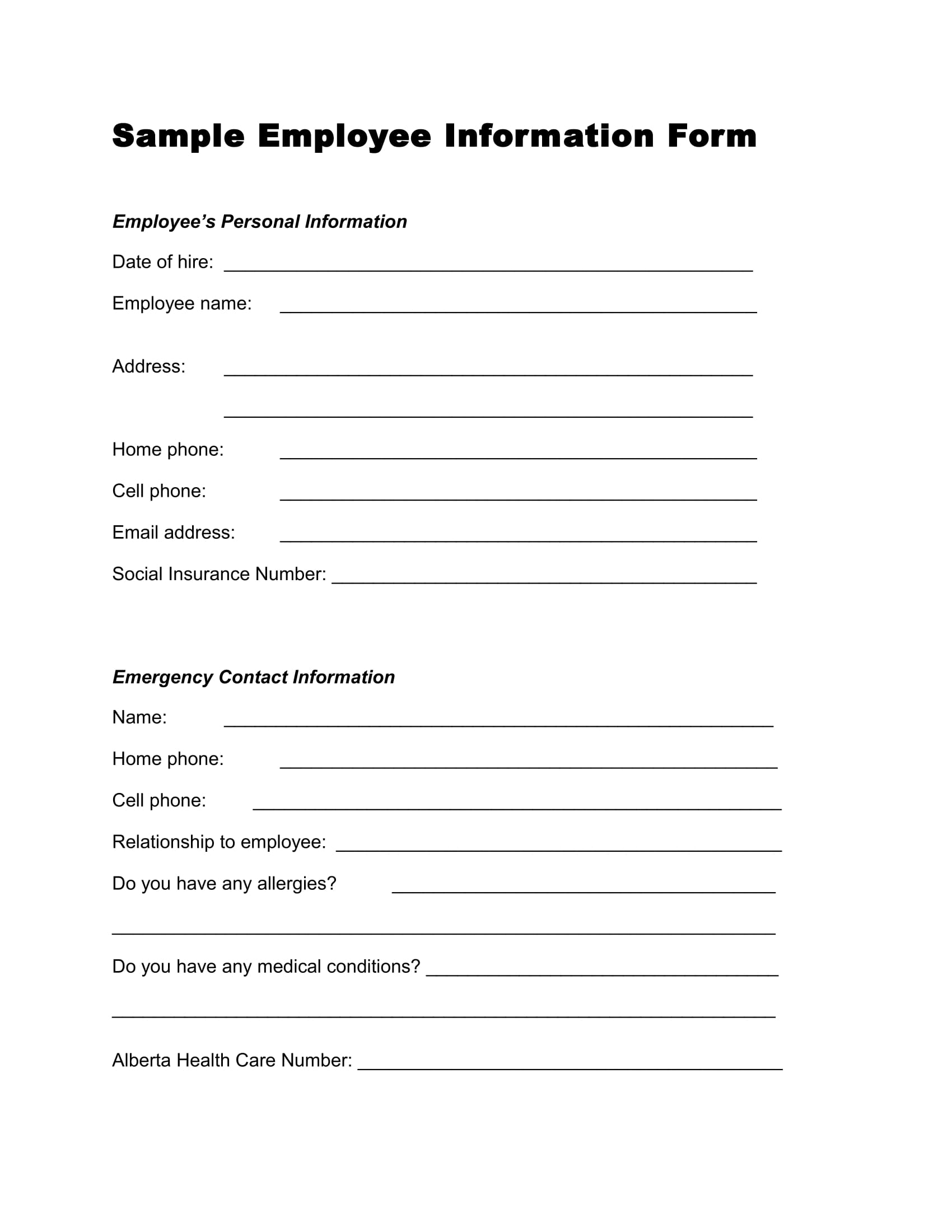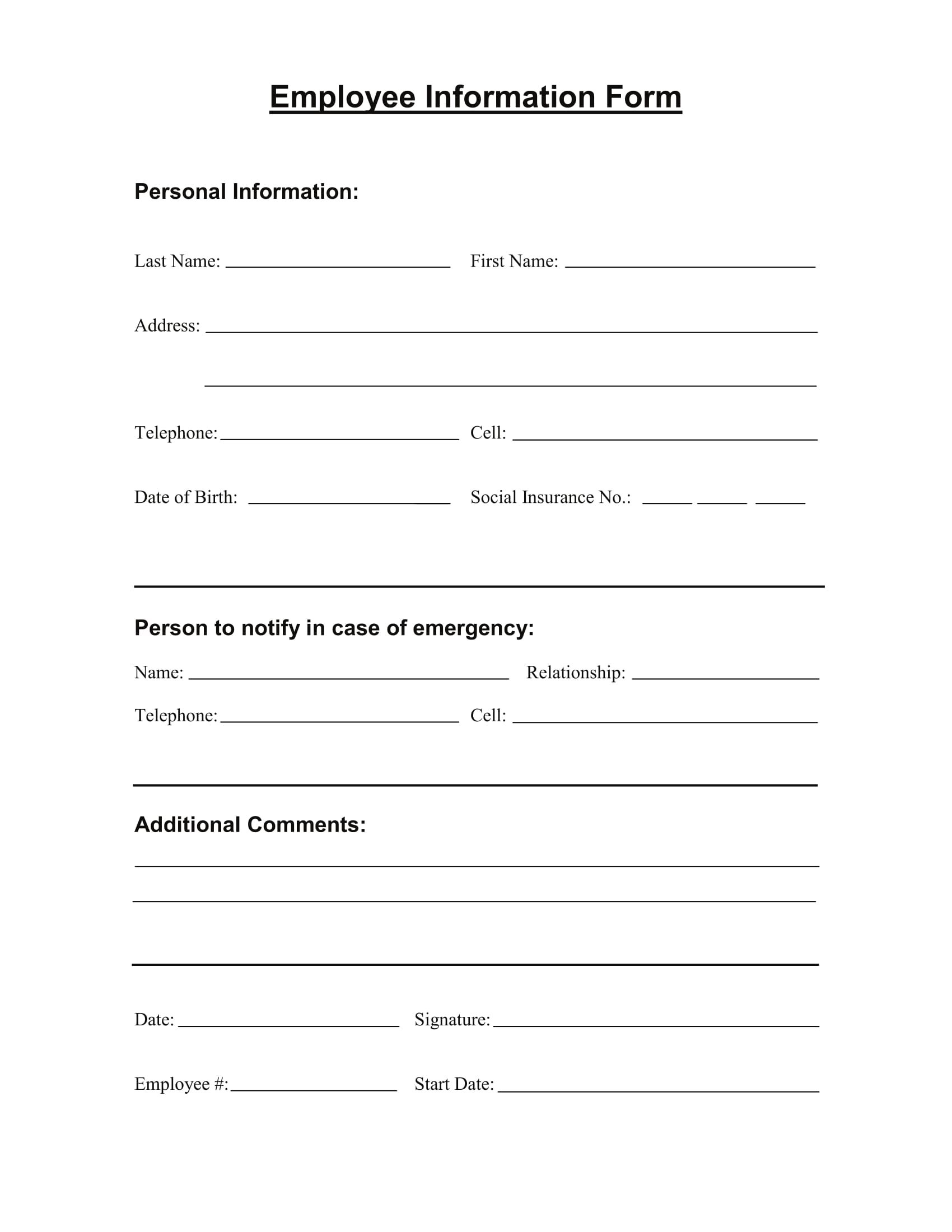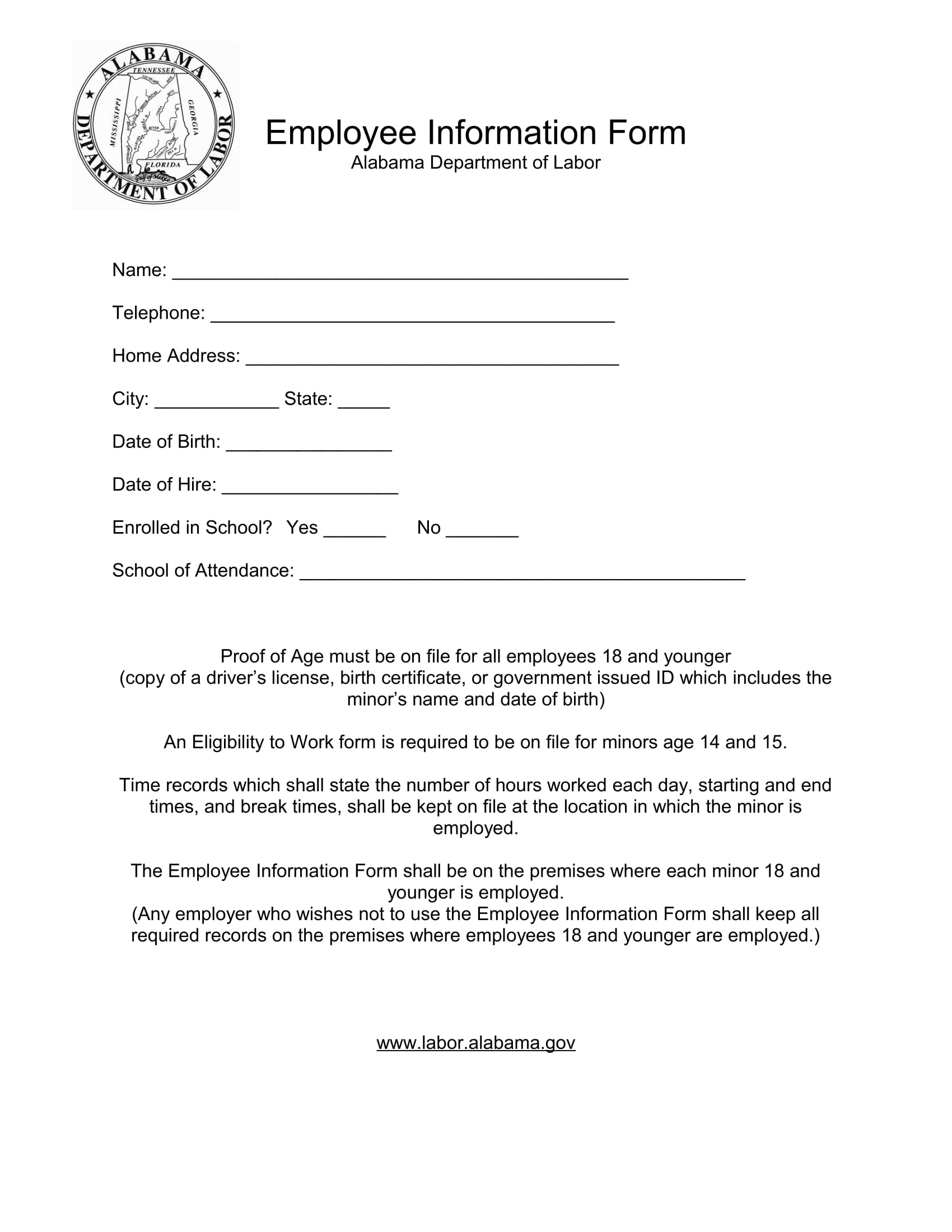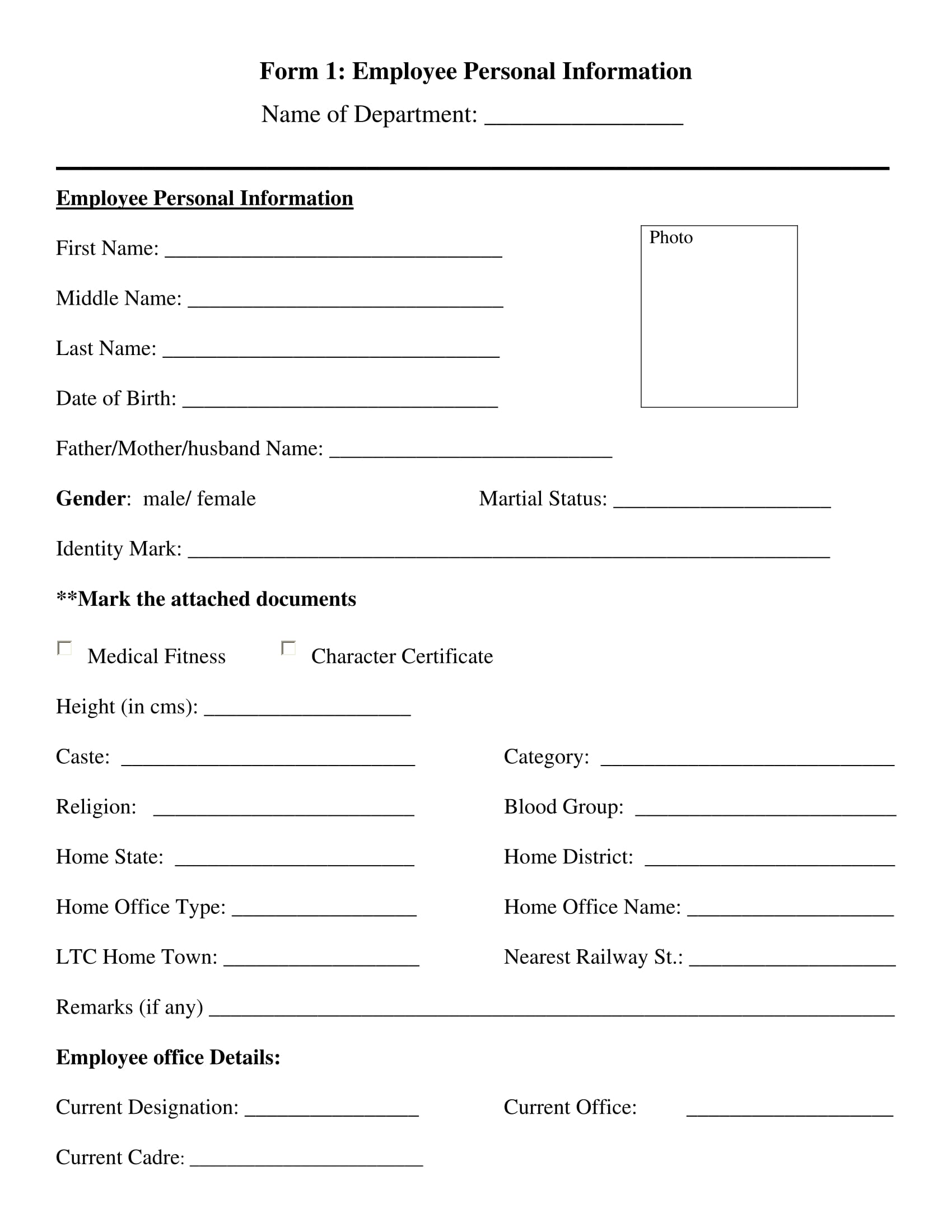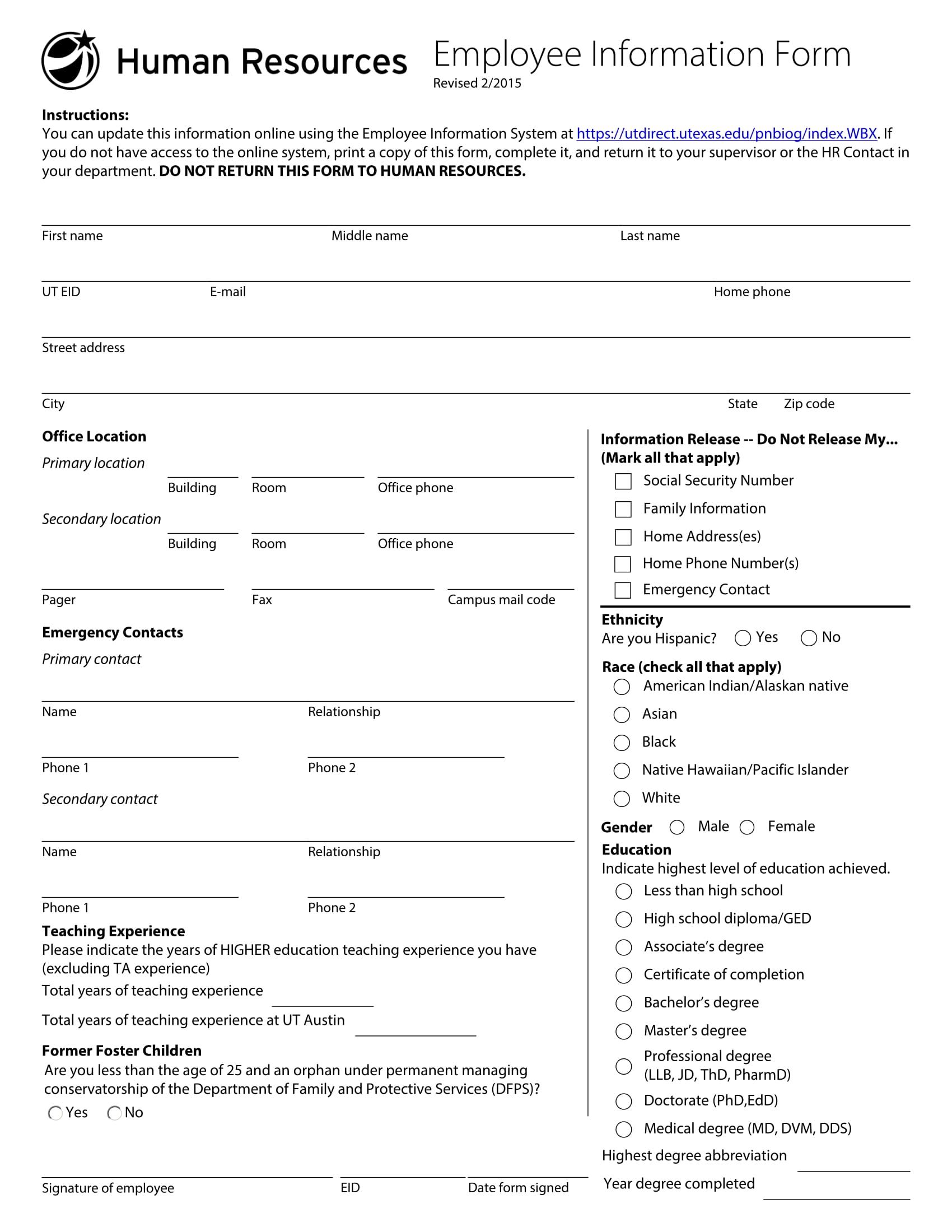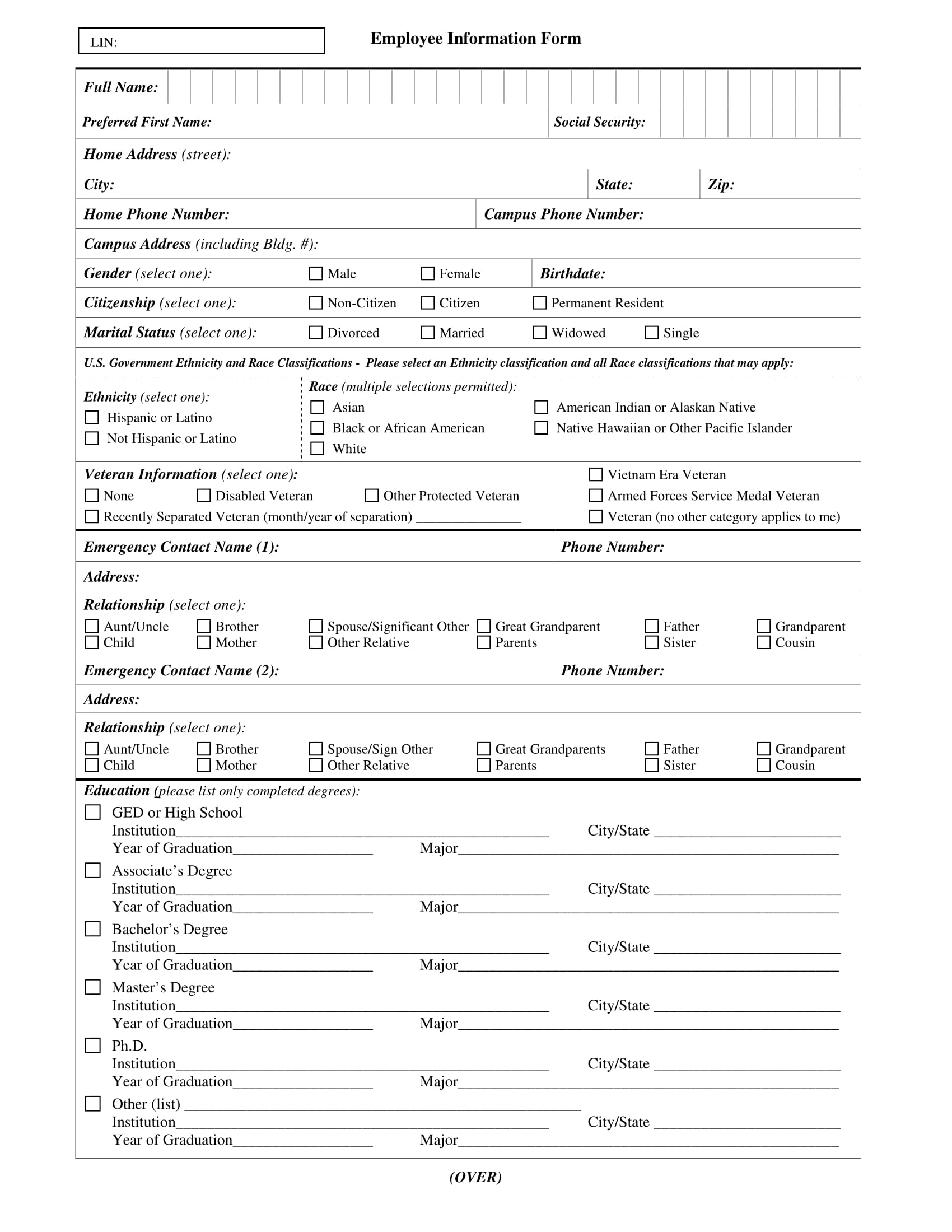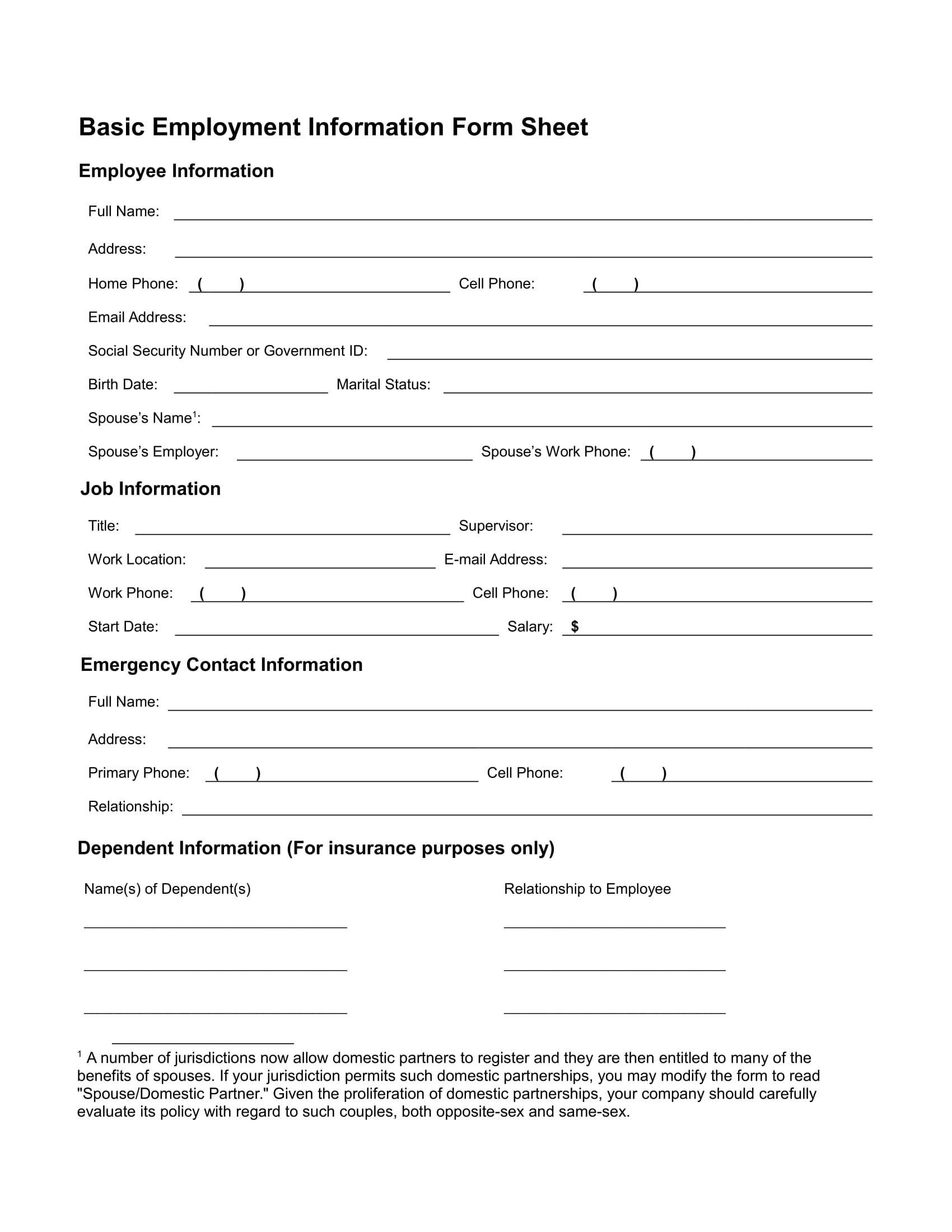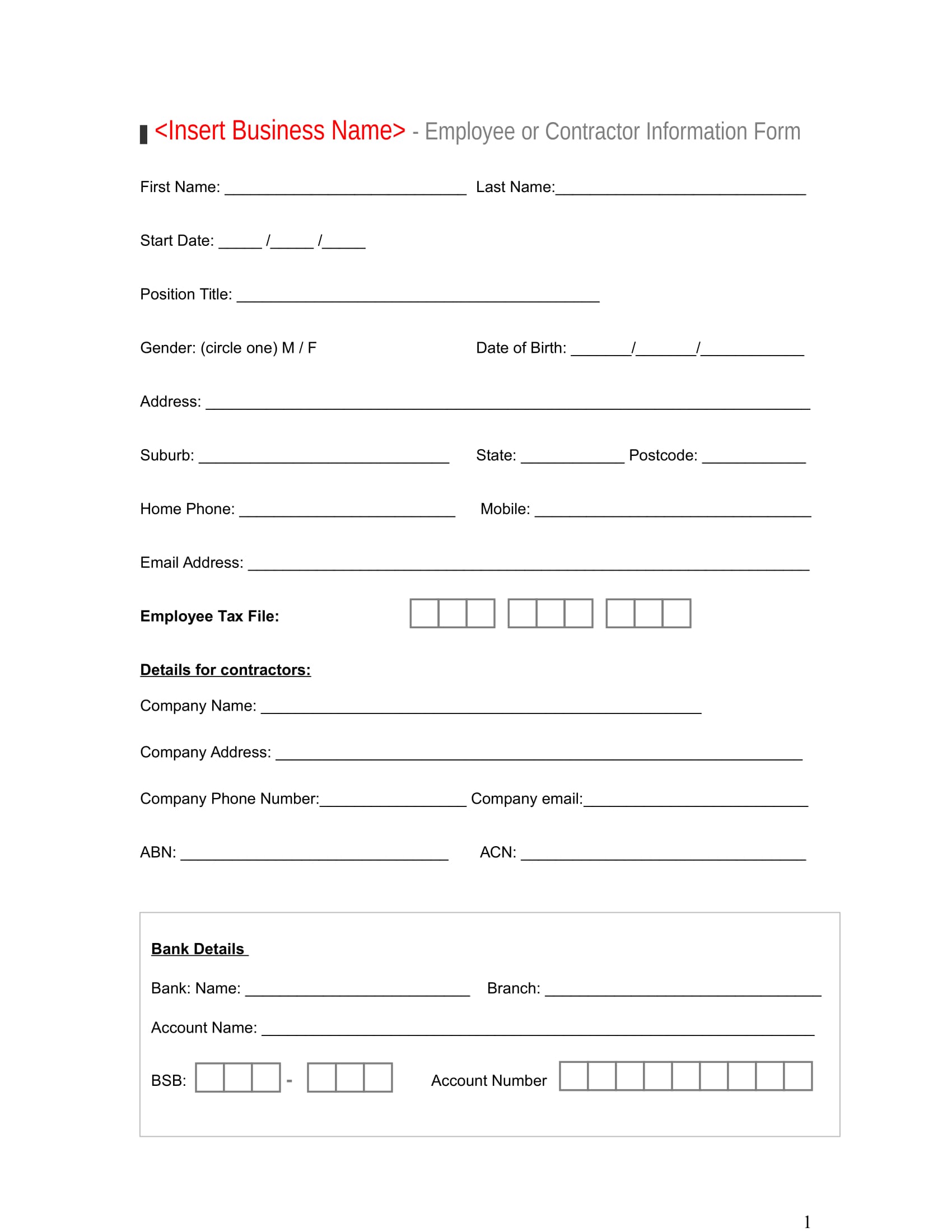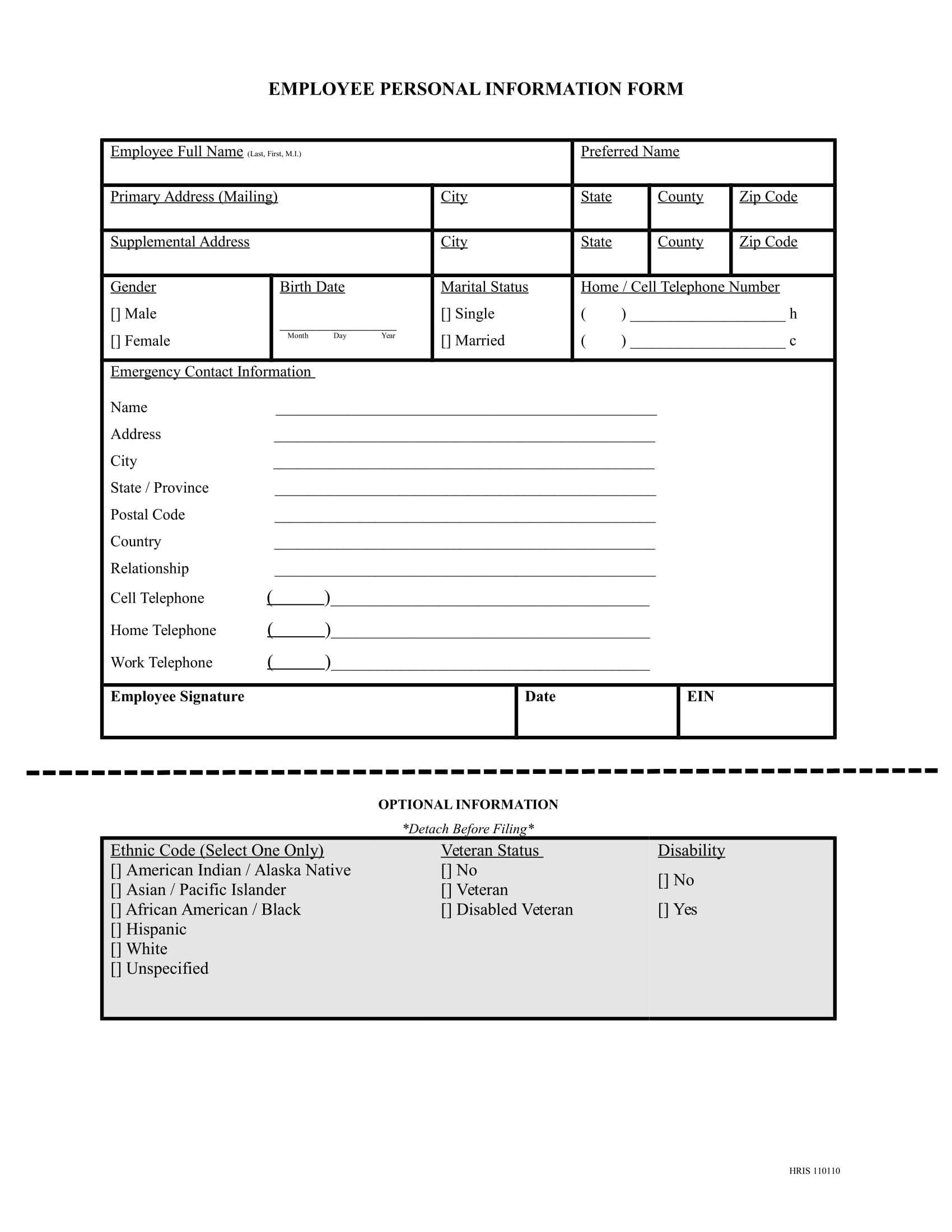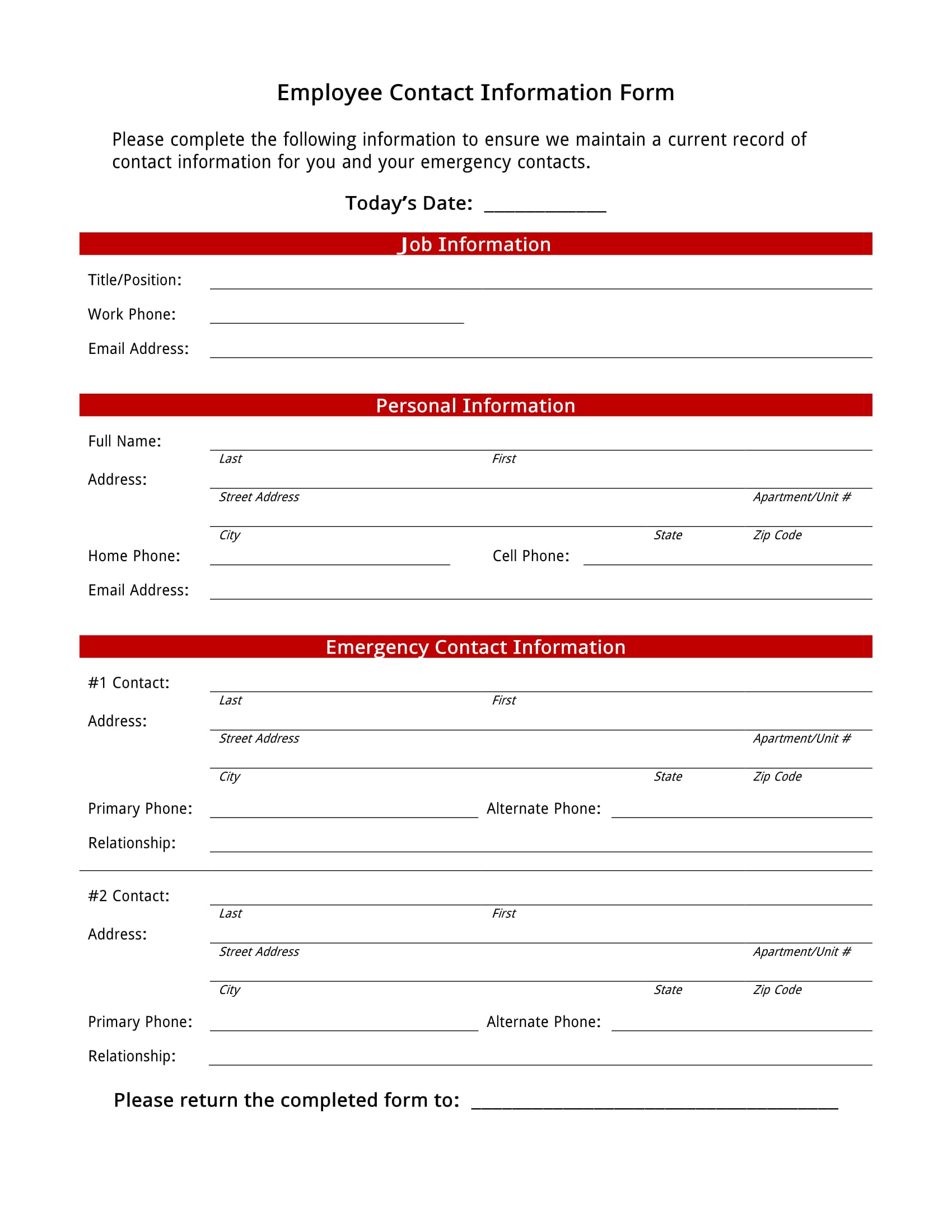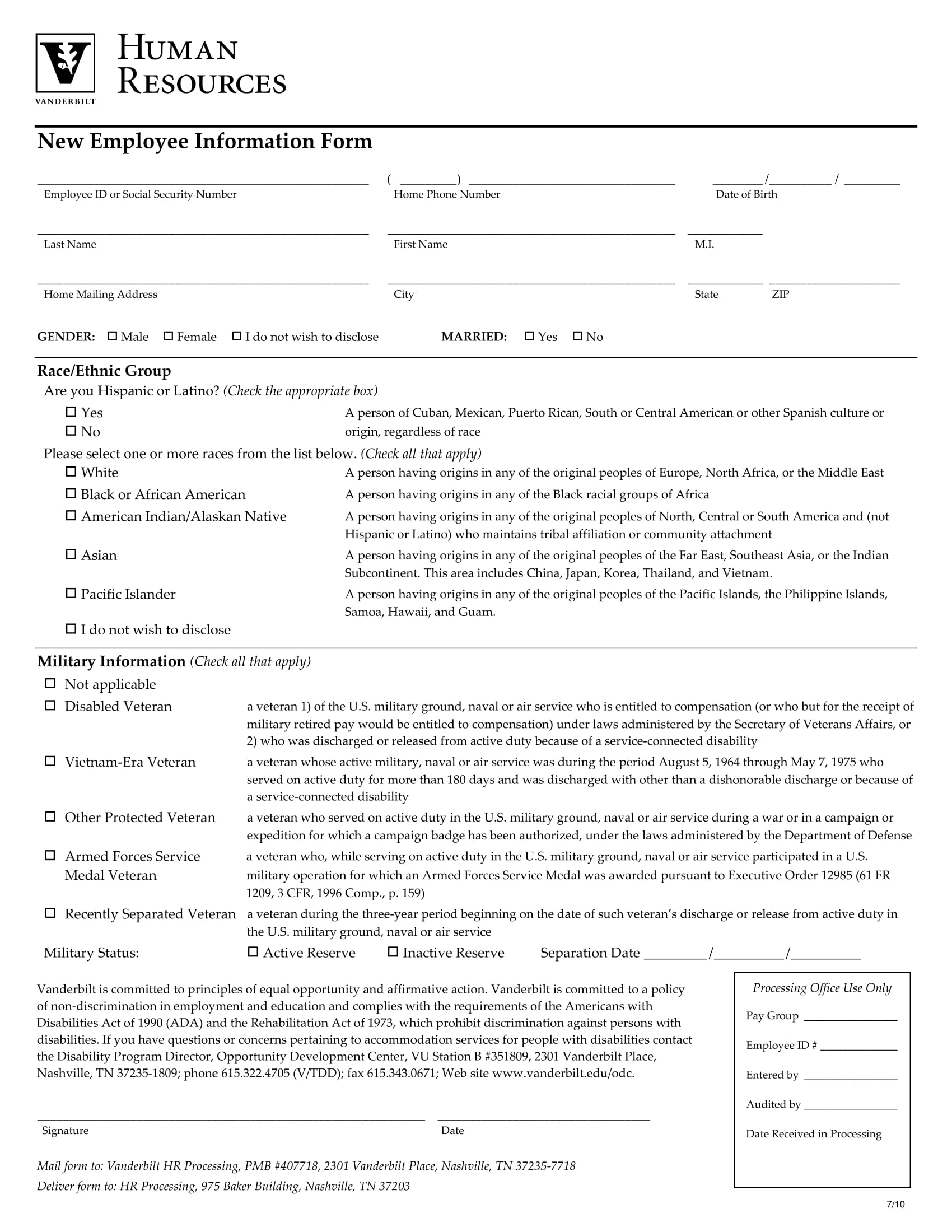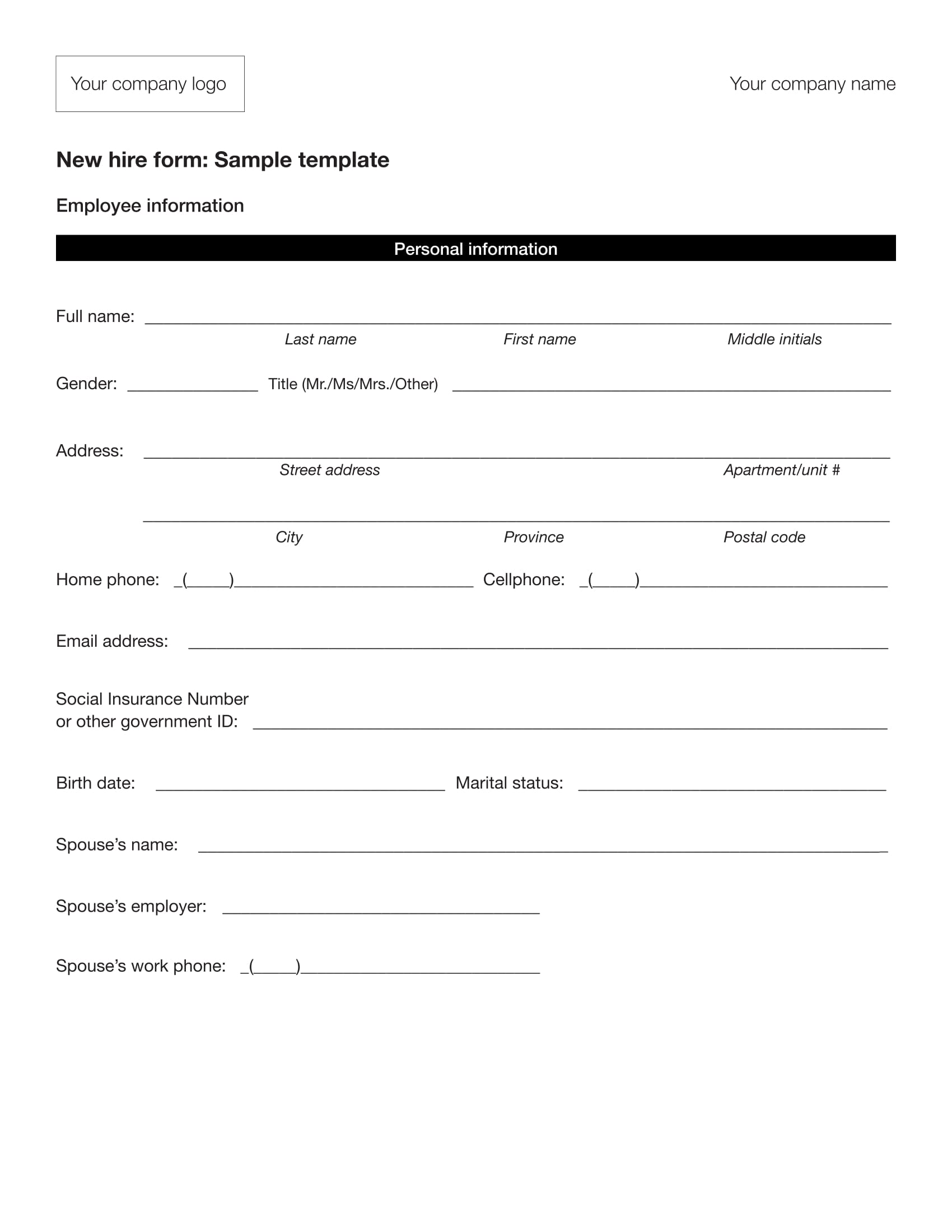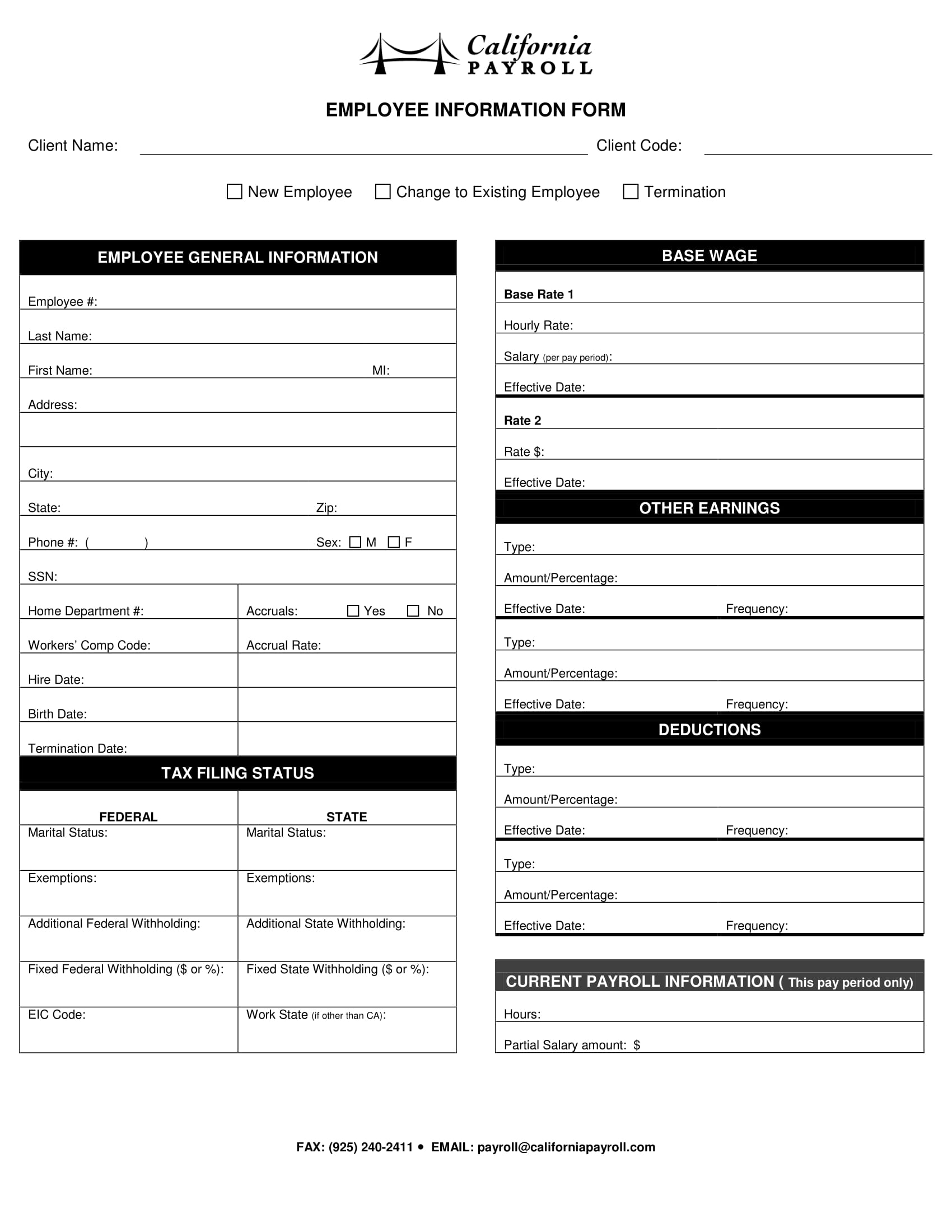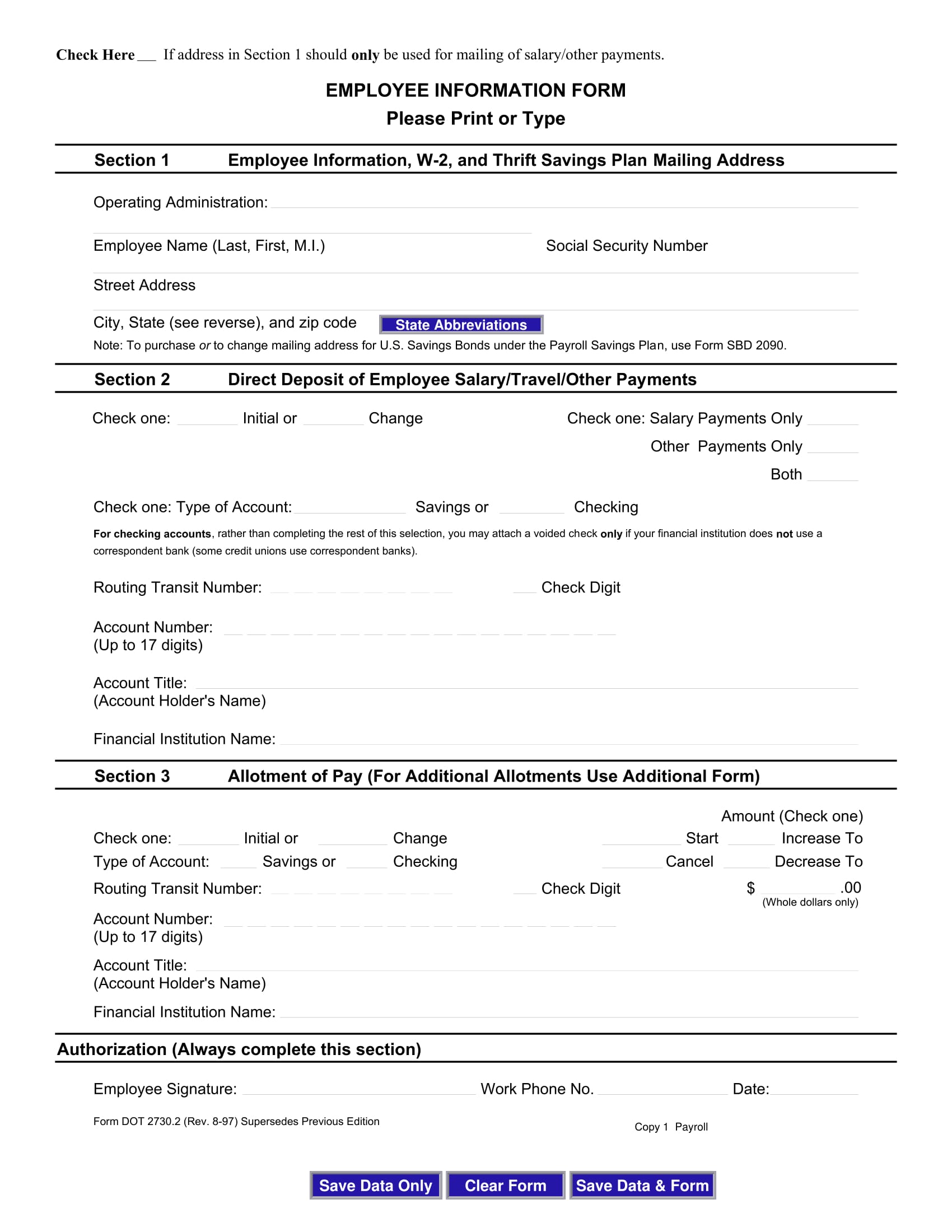Navigate the complexities of collecting employee details with our Employee Information Form guide. This resource is packed with insights, offering practical examples to ensure you capture all the necessary data efficiently. Whether it’s updating records or onboarding new hires, our guide empowers HR professionals with the right tools. Dive into our keyword-rich content to make the Employee Form and Information Form process seamless and error-free for your organization.
Download Employee Information Form Bundle
What is an Employee Information Form?
An Employee Information Form is a crucial document used by HR departments to gather essential details about employees. It typically includes personal information, contact details, emergency contacts, and sometimes, employment history. This form is fundamental for effective record-keeping and ensures that the organization has all the necessary data to manage its workforce efficiently. It serves as a foundational piece for HR processes, from payroll to emergency response planning.
The Employee Information form Includes:
- Name with Address and Contact Number
- Social Security Number
- Title and Department
- Start Date & Salary
- Educational Background & Work History
Employee Information Form Format
Personal Information:
- Full Name:
- Date of Birth:
- Gender:
- Social Security Number (SSN):
- Marital Status:
- Contact Number:
- Email Address:
- Home Address:
- Emergency Contact Name:
- Emergency Contact Phone:
Employment Details:
- Job Title:
- Department:
- Supervisor/Manager Name:
- Date of Hire:
- Employment Status (Full-time/Part-time/Contract):
- Work Schedule:
Salary and Benefits:
- Salary:
- Pay Frequency:
- Benefits Enrollment Date:
- Health Insurance Plan:
- Retirement Plan:
Education and Qualifications:
- Highest Education Level:
- Institution:
- Major/Field of Study:
- Graduation Year:
- Certifications:
Previous Employment:
- Company Name:
- Job Title:
- Employment Dates:
- Reason for Leaving:
Additional Information:
- Languages Spoken:
- Skills or Specializations:
- References (Name, Contact Information, Relationship):
Declaration: I certify that the information provided above is accurate to the best of my knowledge.
Signature: _______________________ Date: ___________________________
Employee Personal Details Form PDF, Word, Google Docs
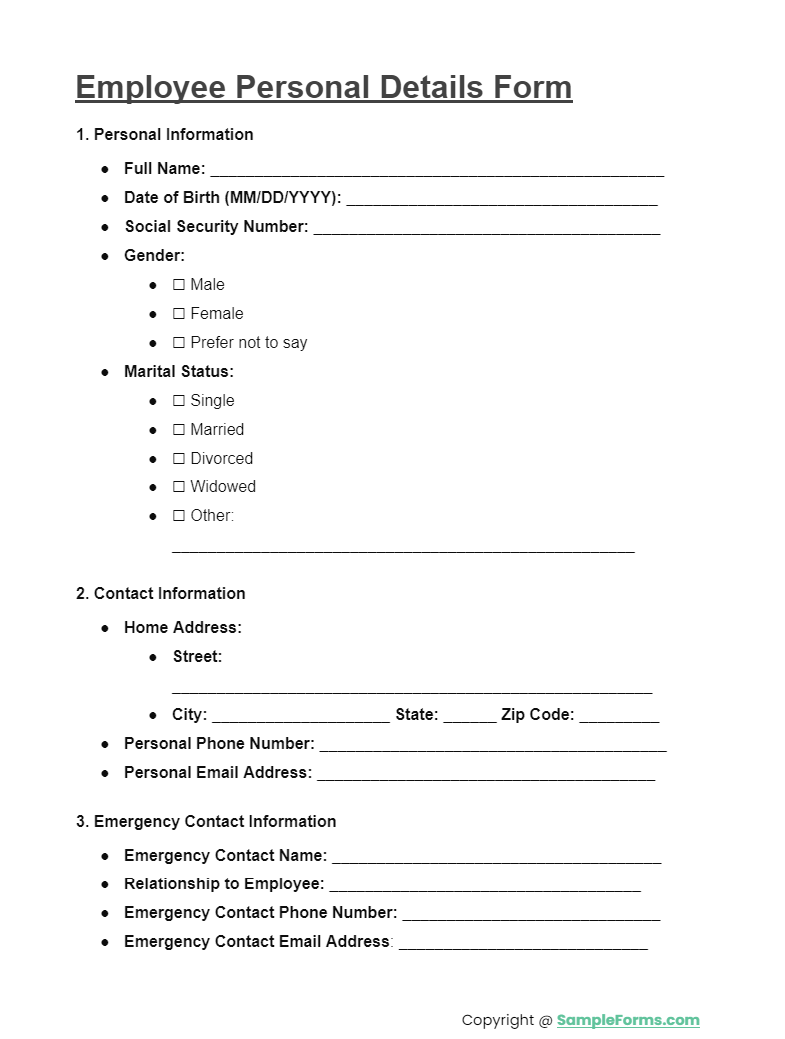
An Employee Personal Details Form collects personal information for restaurant staff management. Similar to a Personal Information Form, it’s essential for compiling comprehensive profiles, akin to restaurant employee forms.
New Hire Employee Information Form
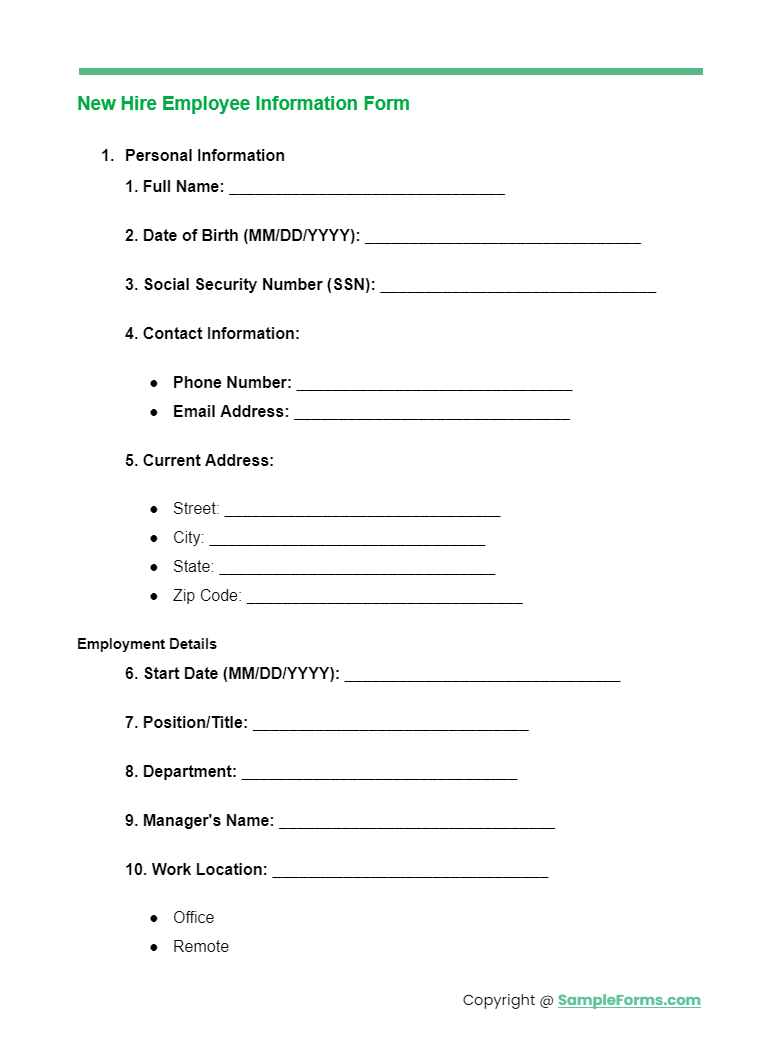
The New Hire Employee Information Form is crucial for integrating new employees. It serves a similar purpose as Patient Information Form and Student Information Form, ensuring all necessary data is systematically gathered.
Employee Information Form for Employee
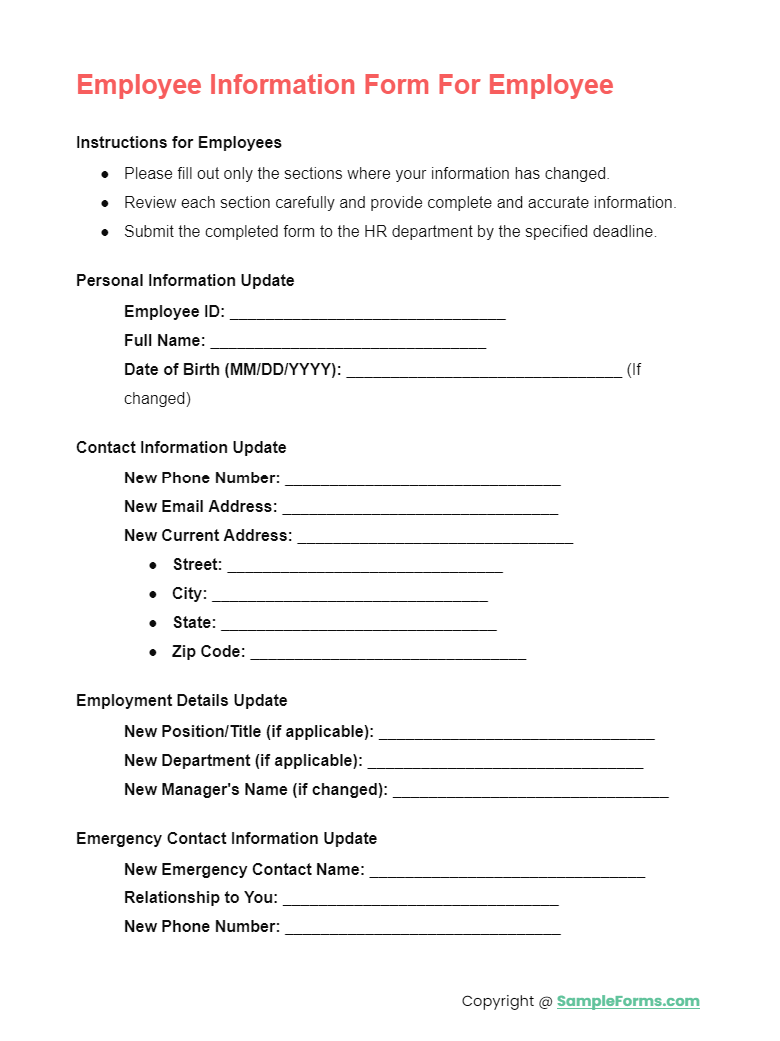
This Employee Information Form facilitates the release of information akin to a Release of Information Form. It’s versatile, used in contexts ranging from customer to employee data collection, mirroring a Customer Information Form.
Employee Information Form Template Free Download
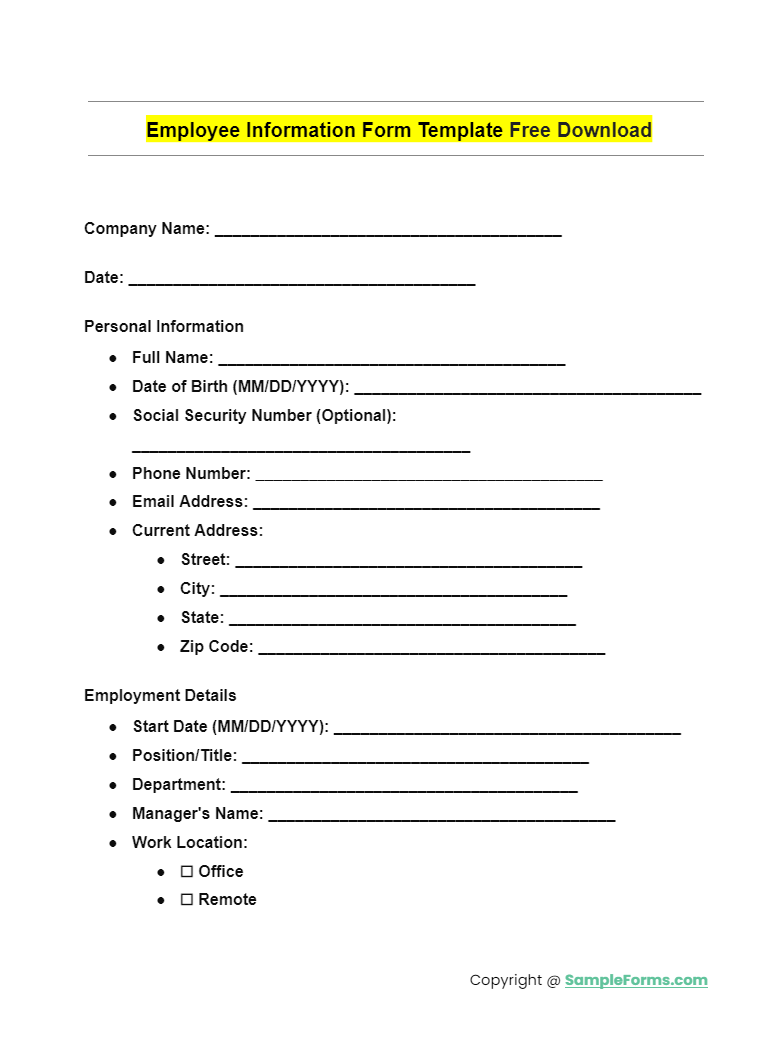
Access a free Employee Information Form Template designed for efficiency. This template is as useful as a Tenant Information Form or Vendor Information Form, offering a streamlined approach to data collection.
Employee Details Form
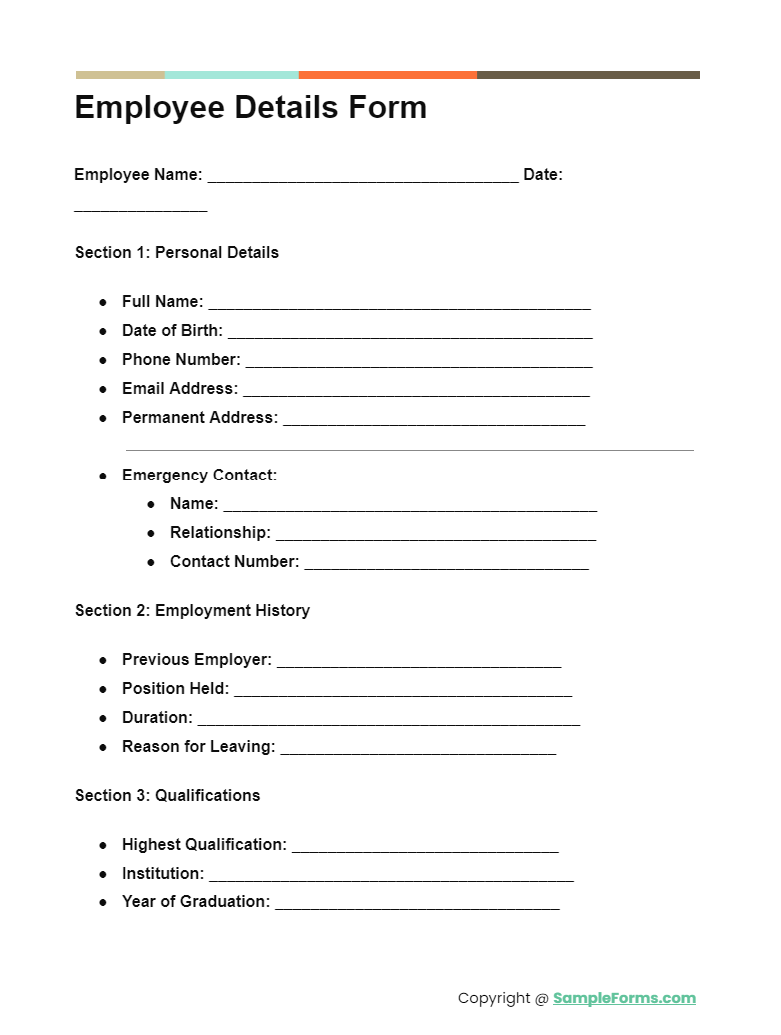
Sample Employee Information Form
Printable Employee Information Form
Employee information forms are composed of different parts, and these depend on what type of information companies require from their employees. Technically, these forms are basically focused on the Employee Personal Information Form. Yet, some companies would also require the past records, such as the education and training information. By means of providing these past data, the information form is then used as a basis during the employees’ interview during their job application.
Editable Employee Information Form
Downloadable Employee Personal Details Information Form
HR Employee Information Form
Employee Information Form PDF
Basic Employment Information Sheet
Employee Data Information Form
Employee Personal Information Form
Employee Contact Information Form
New Employee Information Form
New Hire Employee Information Form Example
New Employee Information Form
Employee Information Form Sheet
Parts of Employee Information Form
Employee information forms, from the word itself, are basically concerning with information regarding the employee. These forms are utilized by the authorized personnel to either add new or update existing information. Either of the two, it is mandatory that these updates are made soon as changes occur. This is to make sure that the company has all their management files current and up to date.
These information forms are composed of the following parts:
The Employee Information
- The full name
- The present and permanent residential address
- The contact number of both home and personal
- The social security information
- The citizenship (either a non-citizen, citizen, or a permanent resident)
- The race or nationality
- The date of birth
- The gender
- The marital status (either divorced, married, widowed, or single)
These are the basic information that the management should secure first before going deeper to the personal information of individual employees. It is important that you know who you are dealing with, before going to deal with this particular person.
The Spouse and Dependent Children Information
- The full name of each
- The social security numbers of the individual
- The relationship to the employee (either child, handicapped dependent, husband, wife, or sponsored child)
- The birth date of each dependent
- The gender (optional)
These information release form serve as the basis for different situations. The most common is to know who are the beneficiaries of the employee, just in case something happens.
The Education Information
- The level of education attainment
- The institution
- The year of graduation
- The city or state
- The degree or major taken
These information would help the management determine how far the employee had accomplished during his or her years in learning.
The Training Information
- The training type
- The training description
- The name of institute
- The name of the sponsor
- The start and end date of certain training
By referring to these information or details, the management are able to measure the employees’ or applicants’ capabilities. By means of this, they could conduct trainings that would be fit for the employee.
The Job or Employment Information
- The employee code or number
- The job title or position
- The company name
- The name of the supervisor
- The work or company site/location
- The work or company contact number
- The hire or start date for employment
- The Employment Information Form (either new, existing employee, or subject for termination)
- The base wage/hourly rate and basic salary per period or term
- The additional earnings (indicate the type, the amount or percentage, the effective date, and the frequency)
- The deductions (specification of the type, the amount or percentage, the effective date, and the frequency)
- The current Employee Payroll Form information (the number of hours and the partial salary amount)
There are various of reasons why employees’ past employment is also mandatory to be provided. One is that the current employer could determine if the applicant is experienced enough and if he or she has a good exit from that past job.
The Emergency Contact Information
- The full name of the person to contact
- The present and permanent residential address
- The contact information form such as the primary and alternate phone number
- The contact person’s relationship to the employee
These information are essential most especially when there are circumstances that are encountered. This part is technically for the employee’s family or relatives to be notified when there are accidents or incidents.
The Acknowledgment Details
- The employee’s name
- The affixed signature
- The date signed
These details are indicated in order to make sure that all information written or provided in the form are true and correct.
What Forms are needed for Employees?
For proper employee forms management and legal compliance, several forms are typically needed throughout the employment lifecycle. Here are key forms that are commonly required:
- Job Application Form: Collects applicant information, qualifications, and experience.
- Resume or CV: Provides detailed work history and educational background.
- Cover Letter: Offers additional context to the application and the candidate’s interest in the position.
- Employee Information Form: Gathers personal and contact information for use in the company’s administrative records.
- Form W-4 (US): Used by employers to determine the correct federal income tax to withhold from employees’ paychecks.
- Form I-9 (US): Employment Eligibility Verification form required by the Department of Homeland Security to verify an employee’s legal right to work in the United States.
- State Tax Withholding Form: Similar to the federal W-4 but for state taxes, where applicable.
- Direct Deposit Form: Collects banking information for payroll purposes.
- Emergency Contact Form: Information on who to contact in case of an emergency involving the employee.
- Employee Handbook Acknowledgment Form: Confirms that the employee has received and understands the company’s policies and procedures.
- Benefits Enrollment Forms: For opting into health insurance, retirement plans, and other employee benefits.
- Non-Disclosure Agreement (NDA): Protects proprietary company information.
- Non-Compete Agreement: Restricts employees from working with direct competitors for a certain period after leaving the company.
- Job Description and Performance Expectations: Outlines the duties and performance standards for the position.
- Performance Review Forms: Used for evaluating employee performance.
- Termination Form: Documented notice of an employee’s termination with the company.
- Exit Interview Form: Used to gather feedback from departing employees about their work experience.
These forms can vary based on the country’s labor laws, state regulations, and the specific needs of the employer. It’s important to stay updated with local employment laws to ensure all necessary documentation is in order.
What is the Employee Information Application Form?
An Employee Information Application Form, often simply referred to as an Employee Information Form, is a document that employers use to collect essential data about their employees. This form typically includes fields for personal information, contact details, emergency contacts, and sometimes employment history or qualifications.
The primary purpose of this form is to have a comprehensive record of all employees that can be used for administrative purposes, payroll, communication, and in case of emergencies. It’s one of the first documents an employee fills out when they join a company and may be updated periodically to ensure all information is current. Our Printable Forms is also worth a look at.
What is Employee Information Summary Form?
An Employee Information Summary Form is a consolidated document that provides a snapshot of an employee’s key personal and professional information. It typically includes:
- Personal details like name, address, phone number, and email.
- Emergency Contact Information Form.
- Employment details such as job title, department, and supervisor.
- Hire date and employment status (full-time, part-time, temporary, etc.).
- Payroll information, including tax withholding details and possibly bank account information for direct deposit.
- Benefits enrollment information, including health insurance, retirement plans, and other company-provided benefits
This form is used by employers to quickly access the most important information about an employee, often for administrative purposes, payroll processing, and contact lists. It’s a summary, so it’s more concise than the full employee file which would include more detailed documents and records.
What Information is Required for Employees?
Employee information typically includes a Background Check Information Form and a Statement of Information Form. These documents collect essential personal and professional details for verification and record-keeping purposes.
How Do You Write Employee Details?
Writing employee details involves accurately filling out a School Information Form and a Medical Information Form. These forms should include comprehensive educational background, health status, and emergency contact information.
What is the Employee Information Record?
An Employee Information Record is a comprehensive document that combines a Product Information Form and a Daycare Information Form. It details an employee’s personal data, work history, and childcare requirements if applicable.
How Do I Verify Employee Information?
To verify employee information, utilize a Health Information Form. This form is crucial for confirming the accuracy of health-related details provided by the employee, ensuring workplace safety and compliance.
How Do You Keep Track of Employee Information?
Keeping track of employee information efficiently requires a Background Information Form and a Buyer Information Form. These forms help in organizing and maintaining essential employee data for HR management and operational needs.
Related Posts
-
FREE 13+ Accident Information Forms in MS Word | PDF
-
FREE 5+ Student-Athlete Forms in PDF | MS Word
-
FREE 11+ Athletic Participation Forms in PDF | MS Word
-
Tenant Information Form
-
FREE 17+ The Uses of Information Forms in PDF | Ms Word | Excel
-
FREE 24+ General Release of Information Forms in PDF | Ms Word
-
Information Form
-
FREE 9+ Sample Information Request Forms in PDF | MS Word | Excel
-
FREE 8+ Sample Parent Information Forms in PDF | MS Word
-
FREE 10+ Sample School Information Forms in PDF | MS Word | Excel
-
FREE 9+ Sample Employment Information Forms in PDF | MS Word
-
Vendor Information Form
-
FREE 9+ Sample Emergency Information Forms in PDF | MS Word
-
Customer Information Form
-
Patient Information Form
